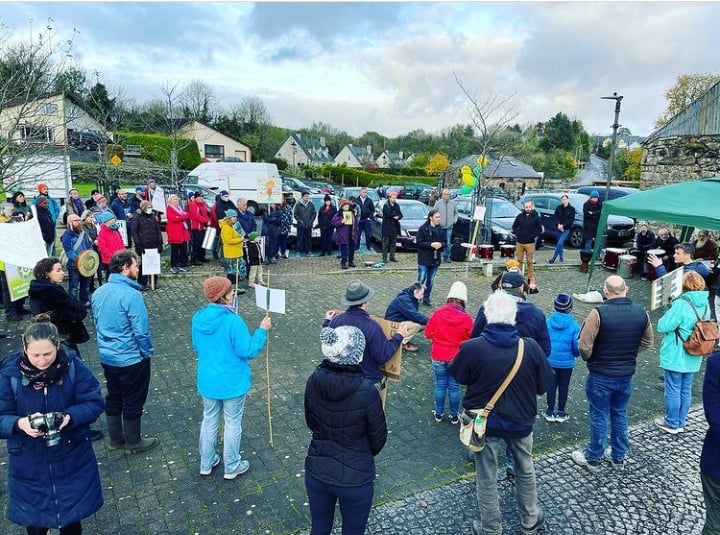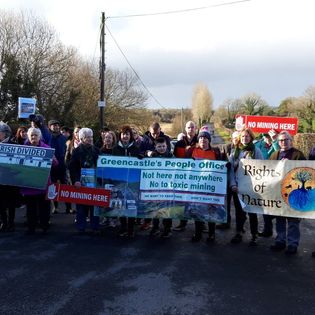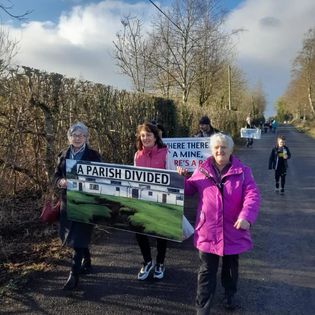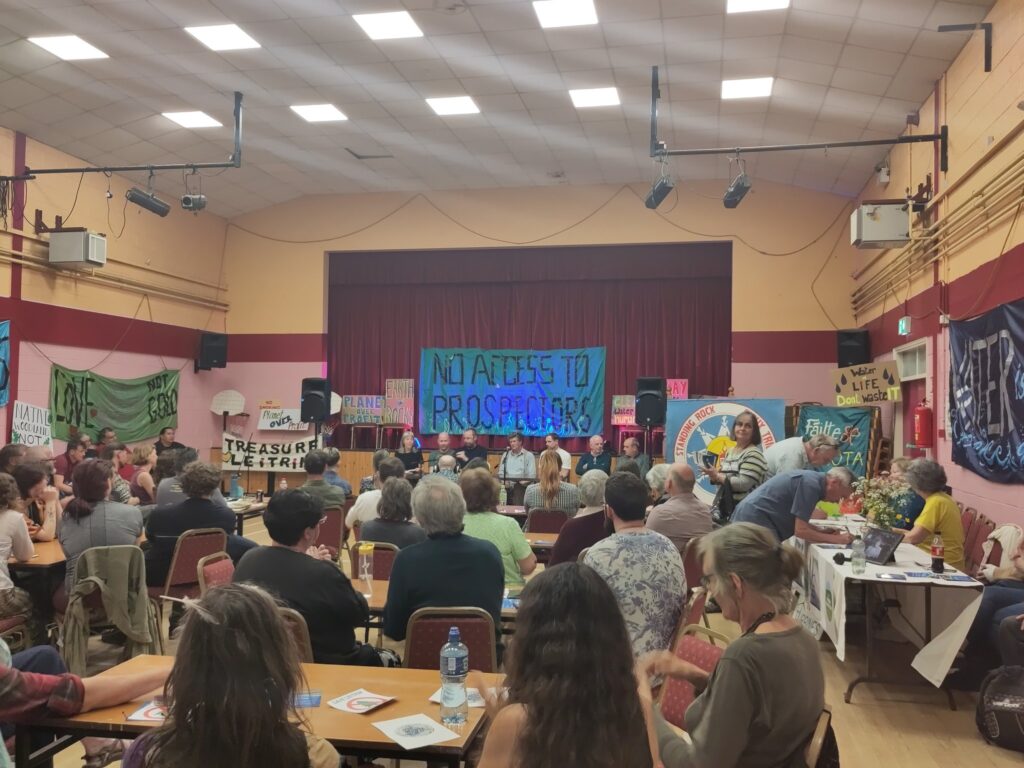Mining Prospecting across the Island
Across Ireland 19% of ROI and 27% of NI’s land area is issued in prospecting licences. These licences are for the mining of minerals and metals such as lithium and are held by around 40 mining companies.
Click here to read more about this
In the Republic of Ireland (ROI), as of June 2023, there were 385 mining prospecting licences issued by the Minister of Environment, Climate, and Communications, held by 40 mining exploration companies. Calculating each prospecting licence as approximately 35 square kilometres, that means 19% of ROI is under mining prospecting licences.
Many of these licences were issued in the past decade, and they cover many counties and many types of minerals and metals, including zinc, lead, gold, silver, copper, lithium, barite, Platinum Group Metals, cobalt, antimony and Rare Earth Elements.
The percentage of the land area of ROI under mining prospecting licences has been as high as 27%; this is because the total area is constantly in flux as licensing applications and concessions change. The government publishes a twice yearly report with information on the status of the mineral exploration and mining sector in Ireland.
Almost 25% of the total land area of Northern Ireland (NI) has been issued for mineral prospecting licences. The companies awarded prospecting licences include; Dalradian Resources Limited, Conroy Gold and Natural Resources, Islandmagee Energy Storage, Irish Salt Mining and Exploration, Karelian Diamond Resources, Koza Gold, Mountcastle Trust, Flintridge Resources, and LaFarge Cement. Dalradian Resources own 10% of the land surface in NI in prospecting licences.
The Department for the Economy in NI publishes data and maps of prospecting licences on this page. The only legislation in NI relating to mineral exploration is the 1969 Mineral Development Act, campaigners highlight it is grossly out of date and out of step with important international legislation.
Those figures of 19% of ROI and 27% of NI’s land area issued in prospecting licences compares with an estimated 7.7% coverage of Scotland, 6.4% coverage of Wales and 0.2% of England – according to environmental journalist Tommy Greene’s approximate calculations of data held by the Coal Authority and the crown estate.
There has been a growth in mining prospecting across the island recently, however the legislative framework to facilitate mining in the ROI has been in place for much longer, according to Dr Conor McCabe in his book Sins of the Father. The Irish government facilitated multinational corporations to extract and export mined minerals through tax exemptions in legislation passed in 1957, leading to a rush of interest from Swedish and Canadian corporations. According to McCabe, another Act in 1967 meant that “Canadian companies had been given Ireland’s mineral resources, effectively, for free.”
In NI, mining emerged during the 2000s as mining corporations took advantage of the hard won peace after 30 years of conflict, according to Lynda Sullivan in the report Our Existence is our Resistance: Mining and Resistance on the Island of Ireland.
Friends and members of the CAIM network have written about the extractive drive across the island in an academic article in October 2022: “There are no restrictions – ecological, archaeological, religious or cultural – placed on the activity apart from built-up urban centres. The religious site of Glendalough, for example, is included in the south, as is the UNESCO World Heritage site of the Burren and all protected Areas of Outstanding Natural Beauty (AONB) in the north.”
The new Policy Statement on Mineral Exploration and Mining (December 2022) now prohibits exploration and mining in national parks, however, Ireland has the lowest national park coverage in Europe at just 0.9% of the country. Mining can still occur in Ireland’s Natura 2000 network of EU protected sites, which cover 13% of the country. These European sites are called either Special Areas of Conservation (SACs) or with a higher protection status Special Protection Areas (SPAs), but are constantly under threat and are already degraded, with Ireland performing worst at EU level in delivering protection and protecting biodiversity.


Prospecting is the Precursor to Mining
One step in the exploration process that comes before mining is prospecting for minerals. It entails hiring geologists and geoscientists to work for a company in order to determine if a mineral deposit is profitable.
Prospecting is free from regulations under the Planning Acts and Regulations in the Republic of Ireland under the category of exempted development due to prospecting being presented in government policy documents as a minor, non-invasive procedure
Click here to read more about this
Prospecting for minerals is an exploratory stage before the mining process. It involves engaging geoscientists/geologists in a company or partnership to find out whether a mineral deposit is commercially viable. If a company holds a licence to prospect in a particular area, geoscientists/geologists will be contracted to enter the region and use existing surveys and maps to collect a sample.
Maps and surveys will show where deposits are likely to exist, but geoscientists/geologists are required to directly observe mineralisation in outcrops, sediments and soil. If direct observation is promising, the next stage of prospecting will generally involve the drilling of boreholes, trial pits, trenching and probing. In the Sperrins (NI), as of mid-2023, upwards of 1,000 boreholes have already been drilled since 2010.
Prospecting is often presented in government policy documents as a minor, non-invasive procedure. This is reflected in the fact that under Irish law in the Republic prospecting is classed as exempted development and exempted from controls under the Planning Acts and Regulations. An Environmental Impact Assessment (EIA) is also not required for the prospecting stage, even if it is conducted in a delicate Natura 2000 site.
The same situation applies in NI which is no longer subject to the EIA Directive, though equivalent (weaker) UK legislation has replaced it. However, prospecting can have serious consequences, particularly as boreholes for particular minerals and metals can contaminate groundwater and water-permeable rock layers (aquifers).
In ROI, once a company has fulfilled the requirements for a prospecting licence, the Department of Communications, Climate Action and the Environment, which oversees mining, is required to place a notice of the Minister’s intent to issue a prospecting licence in a local newspaper. This is how many affected communities find out about the plans for prospecting in their area. The government also publishes updates on prospecting licence notices on this page.
In NI, companies seeking to prospect for base metals apply for prospecting licences with the NI Department for the Economy, and prospecting licences for gold and silver are issued by the Crown Estate Commissioners. Similar to the Republic, in Northern Ireland communities usually find out about prospecting licences through a notice in the newspaper – companies are required to place a notice in the Belfast Gazette and in one or more local newspapers.
Prospecting means that companies are searching for minerals or metals to mine. If mining companies find a viable mineral deposit they then have to apply for a separate licence to mine, as well as planning permission from the local authority and an Integrated Pollution Control licence from the Environmental Protection Agency. In NI, once a company has found mineral resources they can apply for a mining licence or lease from the Department for the Economy. First, they must also apply for planning permission from the Department for Infrastructure (DfI). An Environmental Impact Assessment and feasibility study for the company are also necessary.
Controversy exists in NI where Permitted Development Rights (PDRs) allow certain activities without planning permission for 4 months. These include drilling boreholes, seismic survey work, excavation and construction work, however you need planning permission for any mineral mining. PDRs were removed for petroleum exploration but remain in place for mineral exploration. A review of PDRs for exploration has been established by the Department for Infrastructure but is yet to be completed.
As the legislation currently stands, prospectors do not have the right to prospect on land without the landowner’s permission, either North or South – no intrusive prospecting activities such as drilling or trenching can be undertaken without the express consent of the landowner or tenant.

Active Mining across the Island
According to the ROI government’s 2022 Policy Statement on Mineral Exploration and Mining, there are currently five active State Mining Licences, all held by Tara Mines / Boliden in Meath for zinc and lead mining.
There are nine State Mining Leases – three for Tara Mines in Meath, one for Irish Gypsum Ltd. / Saint-Gobain Mining (Ireland) Ltd in Monaghan, and five licences for extraction of marble, fireclay and coal in Galway and Laois which have been held since the 1930s-50s.
Tara Mines in Meath and Gypsum Ltd in Monaghan have caused issues such as significant ground subsidence, water and air contamination, and problems with workers’ rights. Despite claims by mining companies that mining brings local jobs and development, this has not been the experience of those member groups of CAIM which are living with the impacts of active mining – Save the Environment of Navan Townlands, and Magheracloone against Mining (Drumgossatt/Knocknacran Residents Group).

The Policy Statement also mentions legacy mines in Silvermines, Co. Tipperary; Avoca, Co. Wicklow, Allihies and Cappaghglass, Co. Cork; Lisdrumgormly, Co. Monaghan; Bunmahon, Co. Waterford and Ballingarry, Co. Tipperary. These mines, though long since closed, have left behind legacy pollution and potential ongoing pollution from infrastructure such as tailings ponds.
In Northern Ireland, there has not been as much mining activity due to 30 years of conflict. The Cavanacaw gold mine near Omagh, was the first modern mining project to open. It’s owned by Galantas Gold, a subsidiary of the Canadian company Galantas Gold Corporation. Due to local campaigners, Galantas were held off 12 years in one of the longest running public enquiries ever. Then the company had to pay residents compensation for effectively imprisoning locals in their homes with constant lorry flow.







